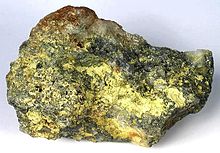This is an old revision of this page, as edited by CheMoBot (talk | contribs) at 04:04, 1 June 2011 (Updating {{chembox}} (changes to watched fields - updated 'UNII_Ref', 'ChemSpiderID_Ref', 'StdInChI_Ref', 'StdInChIKey_Ref', 'ChEMBL_Ref', 'KEGG_Ref') per Chem/Drugbox validation (report [[Wikipe). The present address (URL) is a permanent link to this revision, which may differ significantly from the current revision.
Revision as of 04:04, 1 June 2011 by CheMoBot (talk | contribs) (Updating {{chembox}} (changes to watched fields - updated 'UNII_Ref', 'ChemSpiderID_Ref', 'StdInChI_Ref', 'StdInChIKey_Ref', 'ChEMBL_Ref', 'KEGG_Ref') per Chem/Drugbox validation (report [[Wikipe)(diff) ← Previous revision | Latest revision (diff) | Newer revision → (diff)
| |||
| Names | |||
|---|---|---|---|
| IUPAC name Molybdenum trioxide | |||
| Other names
Molybdic anhydride Molybdite Molybdic trioxide | |||
| Identifiers | |||
| CAS Number | |||
| ECHA InfoCard | 100.013.823 | ||
| CompTox Dashboard (EPA) | |||
| Properties | |||
| Chemical formula | MoO3 | ||
| Molar mass | 143.95 g·mol | ||
| Appearance | yellow or light blue solid | ||
| Density | 4.69 g/cm, solid | ||
| Melting point | 795 °C | ||
| Boiling point | 1155 °C | ||
| Solubility in water | 0.1066 g/100 mL (18 °C) 2.055 g/100 mL (70 °C) | ||
| Structure | |||
| Crystal structure | orthorhombic | ||
| Coordination geometry | see text | ||
| Thermochemistry | |||
| Std molar entropy (S298) |
77.78 J K mol | ||
| Std enthalpy of formation (ΔfH298) |
−745.17 kJ/mol | ||
| Hazards | |||
| Flash point | Non-flammable | ||
| Related compounds | |||
| Other cations | Chromium trioxide Tungsten trioxide | ||
| Except where otherwise noted, data are given for materials in their standard state (at 25 °C , 100 kPa).
| |||
Molybdenum trioxide is chemical compound with the formula MoO3. This compound is produced on the largest scale of any molybdenum compound. It occurs as the rare mineral molybdite. Its chief application is as an oxidation catalyst and as a raw material for the production of molybdenum metal.
The oxidation state of molybdenum in this compound is +6.
Structure

In the gas phase, three oxygen atoms are double bonded to the central molybdenum atom. In the solid state, anhydrous MoO3 is composed of layers of distorted MoO6 octahedra in an orthorhombic crystal. The octahedra share edges and form chains which are cross-linked by oxygen atoms to form layers. The octahedra have one short molydenum-oxygen bond to a non-bridging oxygen.
Preparation and principal reactions
MoO3 is produced industrially by roasting molybdenum disulfide, the chief ore of molybdenum:
- 2 MoS2 + 7 O2 → 2 MoO3 + 4 SO2
The laboratory synthesis entails the acidification of aqueous solutions of sodium molybdate with perchloric acid:
- Na2MoO4 + H2O + 2 HClO4 → MoO3(H2O)2 + 2 NaClO4
The dihydrate loses water readily to give the monohydrate. Both are bright yellow in color.
Molybdenum trioxide dissolves slightly in water to give "molybdic acid." In base, it dissolves to afford the molybdate anion.
Uses
Molybdenum trioxide is used to manufacture molybdenum metal, which serves as an additive to steel and corrosion-resistant alloys. The relevant conversion entails treatment of MoO3 with hydrogen at elevated temperatures:
- MoO3 + 3 H2 → Mo + 3 H2O
It is also a component of the co-catalyst used in the industrial production of acrylonitrile by the oxidation of propene and ammonia.
Because of its layered structure and the ease of the Mo(VI)/Mo(V) couple, MoO3 is of interest in electrochemical devices and displays.
References
- http://www.mallbaker.com/americas/msds/english/m7829_msds_us_default.pdf
- Wells, A.F. (1984) Structural Inorganic Chemistry, Oxford: Clarendon Press. ISBN 0-19-855370-6.
- Heynes, J. B. B.; Cruywagen, J. J. "Yellow Molybdenum(VI) Oxide Dihydrate" Inorganic Syntheses, 1986, volume 24, pp. 191. ISBN 0-471-83441-6.
- Ferreira, F. F.; Souza Cruz, T. G.; Fantini, M. C. A.; Tabacniks, M. H.; de Castro, S. C.; Morais, J.; de Siervo, A.; Landers, R.; Gorenstein, A. Solid State Ionics. 2000, 136-137, 357.
External links
- Greenwood, Norman N.; Earnshaw, Alan (1997). Chemistry of the Elements (2nd ed.). Butterworth-Heinemann. ISBN 978-0-08-037941-8.
- U.S. Department of Health and Human Services National Toxicology Program
- International Molybdenum Association
- Los Alamos National Laboratory- Molybdenum

| Molybdenum compounds | |
|---|---|
| Mo(0) | |
| Mo(II) | |
| Mo(III) | |
| Mo(IV) | |
| Mo(V) | |
| Mo(VI) | |

